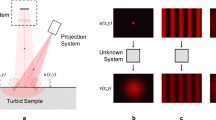Abstract
Biomedical optical imaging in the near-infrared (NIR) region provides the possibility to detect and determine pathological and functional changes in human tissue without the drawback of ionizing radiation. Of special promise is the application of this technology for the detection of joint diseases, such as rheumatoid arthritis (RA). It has been shown that optical changes in the synovial fluid and the vasculature surrounding the joints can be detected with optical methods. Applying optical tomographic methods one should be able to localize and quantify these changes for detection of the onset of RA. The first studies have been limited to continuous wave imaging. However, it is well known that enhanced resolution and better separation between absorption and scattering properties of tissue can be achieved using intensity modulated light sources. Intensity modulation of laser light in the MHz region leads to propagation of so-called diffuse photon density waves (PDW) through the tissue In this study we report on basic experimental results to determine performance and sensitivity of PDW-transillumination of tissue like phantoms. We used a vector network analyzer to generate and analyze intensity modulation from 100 MHz up to 1 GHz via a diode laser and an avalanche photo diode. Scans were performed across phantoms containing a layer with different absorbing and scattering properties bounded by an edge. The thickness of the phantoms was chosen similar to human fingers to gain information for optimization of tomographic imaging of finger joints. We experimentally determined the signal-to-noise ratio (SNR) of the system and compared the results to theoretical predictions. Noise and SNR of amplitude and phase depend on frequency of modulation. While the amplitude SNR decreases with frequency, phase SNR increases to assume a maximum value. We found that the inserted layer can be better characterized using phase information, which becomes more valuable as the source modulation frequency is increased. On the other hand, the sensitivity to perturbations is highest in the amplitude data obtained at lower frequencies. Thus, for tomographic imaging, optimal modulation frequencies should be found depending on the tissue type and nature of tissue inhomogeneities.
Similar content being viewed by others
References
J. Beuthan, O. Minet, G. Müller, and V. Prapavat, in Medical Optical Tomography: Functional Imaging and Monitoring, Ed. by G. Müller, B. Chance, R. Alfano, et al. (SPIE, Bellingham, Washington, 1993), p. 263.
V. Prapavat, W. Runge, A. Krause, et al., Minimal Invasive Med. 8(1–2), 7 (1997).
Y. Xu, N. Iftimia, H. Jiang, et al., Opt. Express 8, 447 (2001).
J. Beuthan, U. Netz, O. Minet, et al., Quantum Electron. 32, 945 (2002).
Y. Xu, N. Iftimia, H. Jiang, et al., J. Biomed. Opt. 7, 88 (2002).
A. K. Scheel, A. Krause, I. Mesecke-von Rheinbaben, et al., Arthritis Rheum. 46, 1177 (2002).
A. Schwaighofer, V. Tresp, P. Mayer, et al., IEEE Trans. Biomed. Eng. 50, 375 (2003).
A. D. Klose and A. H. Hielscher, Med. Phys. 26, 1698 (1999).
A. H. Hielscher, A. Klose, A. K. Scheel, et al., Phys. Med. Biol. 49, 1147 (2004).
A. K. Scheel, M. Backhaus, A. D. Klose, et al., Ann. Rheum. Dis. 64, 239 (2005).
J. B. Fishkin, E. Gratton, M. J. VandeVen, and W. W. Mantulin, Proc. SPIE 1431, 122 (1991).
S. R. Arridge and W. R. B. Lionheart, Opt. Lett. 23, 882 (1998).
S. R. Arridge, Inverse Probl. 15, R41 (1999).
D. A. Boas, M. A. O’Leary, B. Chance, and A. G. Yodh, Appl. Opt. 36, 75 (1997).
J. B. Fishkin and E. Gratton, J. Opt. Soc. Am. 10, 127 (1993).
H. Wabnitz and H. Rinneberg, Appl. Opt. 36, 64 (1997).
J. Beuthan, V. Prapavat, R. Naber, et al., Proc. SPIE 2676, 43 (1996).
I. Mesecke-von Rheinbaben, A. Roggan, J. Helfman, et al., Proc. SPIE 3601, 482 (1999).
V. Toronov, E. D’Amico, D. Hueber, et al., Opt. Express 11, 2717 (2003).
M. S. Patterson, B. W. Pogue, and B. C. Wilson, in Medical Optical Tomography: Functional Imaging and Monitoring, Ed. by G. Müller, B. Chance, R. Alfano, et al. (SPIE, Bellingham, Washington, 1993), p. 513.
L. Montandon, D. Salzmann, F. Bevilacqua, and C. Depeursinge, Proc. SPIE 3566, 236 (1998).
J. B. Fishkin, S. Fantini, M. J. VandeVen, and E. Gratton, Phys. Rev. E 53, 2307 (1996).
U. J. Netz, A. H. Hielscher, A. K. Scheel, and J. Beuthan, Laser Phys. 16, 765 (2006).
A. Roggan, O. Minet, C. Schrönder, and G. Müller, in Medical Optical Tomography: Functional Imaging and Monitoring, Ed. by G. Müller, B. Chance, R. Alfano, et al. (SPIE, Bellingham, Washington, 1993), p. 149.
Author information
Authors and Affiliations
Additional information
Original Text © Astro, Ltd., 2007.
Rights and permissions
About this article
Cite this article
Netz, U.J., Hielscher, A.H., Scheel, A.K. et al. Signal-to-noise analysis for propagation of laser radiation through a tissue-like medium by diffuse photon-density waves. Laser Phys. 17, 453–460 (2007). https://doi.org/10.1134/S1054660X07040238
Received:
Issue Date:
DOI: https://doi.org/10.1134/S1054660X07040238




